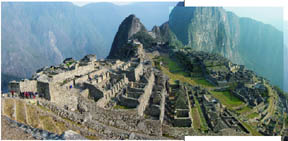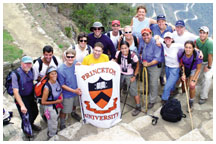
|
|
November 2, 2005: Features

Princeton Journeys trekkers reached Machu Picchu, left, on Aug. 27, their fifth day on Peru’s Inca Trail. Back row, from left, are Vince Lee ’60 *66, Daniel Chirpich ’01, Julien Beguin ’01, Andrew Gossen ’93, Conor Madigan ’00, Lauren Cain ’01, Karna Nisewaner ’96, Nancy Collins ’91, Brad Pontz ’91, and PAW’s Brett Tomlinson. Front row, from left, are Nancy Lee s’60, Matt Moskewicz ’00, Jason Todd ’95, Barbara Calanog Todd ’98, Will Caseber ’93, Liz Hallock ’02, and Laura Chiang ’05. (Photographs: Brett Tomlinson (Machu Picchu photo montage), Nancy Collins '91/Global Adrenaline inc. (group)) |
An Andean adventure
What’s an alumni travel program like? To get a firsthand view, Associate Editor Brett Tomlinson joined 14 young alumni in August as they trekked through Peru and visited Machu Picchu, an abandoned city from the Inca civilization. Here are excerpts from his account. To see an online slide show of the trip, click here.
Sunday, Aug. 21
After arriving in Lima individually yesterday, we head back to the airport as a group and fly to Cuzco, the capital of the Inca empire and the starting point of our trek on the Inca Trail to Machu Picchu. This is the first young-alumni trip organized by Princeton Journeys, and our group ranges from the Class of 1991 to the Class of 2005. Few of the travelers have come to Peru knowing more than one or two of their fellow trekkers, but after informal introductions, we strike up an immediate rapport. On the plane, about 20 minutes outside of Lima, the Andes become visible through the windows, poking through the clouds. Karna Nisewaner ’96 says to no one in particular, “Those are some serious mountains out there.” A few of us reply softly in agreement. “We’re going to climb things like that,” she says. We stare out the window in quiet awe.
Tuesday, Aug. 23
Our study leader for the trip is Vince Lee ’60 *66. As an architect and an experienced mountain guide, Lee came to Peru in the early 1980s to explore the Andes and soon became hooked, poring over the region’s archaeology and history. Lee is particularly amazed by the Incas’ marvelous feats of masonry, and in today’s lecture at the ruins of Ollyantaytambo, he tackles the issue of how the Incas moved such massive stones without the benefit of the wheel. Lee has theorized, based on archaeological evidence, that the Incas pulled large stones over paths of clay and cobblestones, and for a 1994 NOVA program, he joined the people of Ollyantaytambo village in duplicating the feat. Dozens of people pulling on ropes dragged a 10-ton rock uphill for nearly a mile. Says Lee, “Believe it or not, it’s even fun, once you get it moving.”
Wednesday, Aug. 24
We rise early after our first night of camping, greeted by hot tea and coffee at the breakfast table, followed by pancakes. We also meet the porters, who will carry the bulk of our supplies on the trail. They are from Patacancha, from the same village as the porters who helped clear a path for Hiram Bingham, the American explorer who uncovered Machu Picchu in 1911. The porters carry a maximum of 25 kilograms, or about 55 pounds (by comparison, my daypack is about five pounds, fully loaded with two liters of water), and they skip past us on the trail wearing rubber sandals with cloth straps, breathing heavily but rarely showing fatigue.
Thursday, Aug. 25
After spending the night under a gloriously clear, starry sky, we rise for the most challenging day of our trek. We’re slated to walk about six miles, over the course of which we will ascend 3,700 feet to Abra de Warmi Wañusca (“Dead Woman’s Pass”), the highest point on the Inca Trail at 13,776 feet. The trail includes steep slopes, steps, switchbacks, and a handful of frustrating downturns where we groan about the hard-earned elevation that we’re losing. When we finally reach the pass, we place stones carried from the bottom of the trail on top of an apucheca, a pile of modest tributes to the local mountain god. We pause for photos, bundling up in ski caps and fleece jackets as the clouds pass in front of our faces. The name “Dead Woman’s Pass” refers to the shape of the pass, a silhouette of a woman on her back with an open mouth. After we reach our campsite, my tentmate, Will Caseber ’93, assumes the same pose, reclining for a quick nap before dinner. Our boots suddenly seem a bit lighter, with the hardest day of hiking behind us.
Saturday, Aug. 27
Our final day on the trail is a long one as we make the famous “3,000
steps down” to Machu Picchu. By mid-afternoon, we’re back
to climbing up on a series of steep and narrow steps, leaning forward,
grazing the stones with our hands. Finally, we pass around a bend in the
trail and see Machu Picchu in the distance, through the haze — the
image we’ve seen in postcards, laid out in front of us. The first
pictures we take of each other show huge smiles of accomplishment; seeing
ourselves next to the clean-shaven day-trippers who have come here by
train adds to our pride. By hiking the trail, we’ve gotten an understanding
of how isolated this city was. Abandoned before the conquest, Machu Picchu
was never discovered by the Spanish conquistadors, and its well-preserved
beauty is a testament to the benefits of being far off the beaten path.
We take our first close look — we’ll return tomorrow —
and then head toward town via shuttle bus to check in at our hotel and
enjoy the day’s other great reward: a warm shower. ![]()

